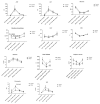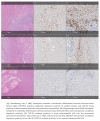The Impact of Chemotherapy and Transforming Growth Factor-β1 in Liver Regeneration after Hepatectomy among Colorectal Cancer Patients
- PMID: 38392578
- PMCID: PMC10890619
- DOI: 10.3390/jpm14020144
The Impact of Chemotherapy and Transforming Growth Factor-β1 in Liver Regeneration after Hepatectomy among Colorectal Cancer Patients
Abstract
An ongoing debate surrounds the impact of chemotherapy on post-hepatectomy liver regeneration in patients with colorectal cancer liver metastases (CRLM), with unclear regulatory mechanisms. This study sought to delve into liver regeneration post-resection in CRLM patients, specifically examining the roles of hepatocyte growth factor (HGF) and transforming growth factor β1 (TGF-β1). In this longitudinal observational study, 17 patients undergoing major liver resection for CRLM and 17 with benign indications as controls were enrolled. Liver regeneration within 30 postoperative days was assessed via CT, considering clinicopathological characteristics, liver enzymes, liver stiffness by elastography, and the impact of HGF and TGF-β1 on liver regeneration. The results revealed that the control group exhibited significantly higher mean liver regeneration volume (200 ± 180 mL) within 30 days postoperatively compared to the CRLM group (72 ± 154 mL); p = 0.03. Baseline alkaline phosphatase (AP) and TGF-β1 blood levels were notably higher in the CRLM group. Immunohistochemical analysis indicated a higher proportion of CRLM patients with high TGF-β1 expression in liver tissues compared to the control group (p = 0.034). Correlation analysis showed that resected liver volume, baseline plasma HGF, AP, and albumin levels significantly correlated with liver regeneration volume. However, in multivariable analysis, only resected liver volume (β: 0.31; 95% CI: 0.14-0.47, p = 0.01) remained significant. In conclusion, this study highlights compromised liver regeneration in CRLM patients post-chemotherapy. Additionally, these patients exhibited lower serum TGF-β1 levels and reduced TGF-β1 expression in liver tissue, suggesting TGF-β1 involvement in mechanisms hindering liver regeneration capacity following major resection after chemotherapy.
Keywords: cancer; liver resection; metastases; regeneration.
Conflict of interest statement
The authors declare no conflicts of interest.
Figures



References
-
- Inoue Y., Fujii K., Tashiro K., Ishii M., Masubuchi S., Yamamoto M., Shimizu T., Asakuma M., Hirokawa F., Hayashi M., et al. Preoperative Chemotherapy May Not Influence the Remnant Liver Regenerations and Outcomes After Hepatectomy for Colorectal Liver Metastasis. World J. Surg. 2018;42:3316–3330. doi: 10.1007/s00268-018-4590-1. - DOI - PubMed
-
- Maneikyte J., Bausys A., Leber B., Horvath A., Feldbacher N., Hoefler G., Strupas K., Stiegler P., Schemmer P. Dietary glycine decreases both tumor volume and vascularization in a combined colorectal liver metastasis and chemotherapy model. Int. J. Biol. Sci. 2019;15:1582–1590. doi: 10.7150/ijbs.35513. (1449-2288 (Electronic)) - DOI - PMC - PubMed
-
- Balzan S., Belghiti J., Farges O., Ogata S., Sauvanet A., Delefosse D., Durand F. The “50-50 criteria” on postoperative day 5: An accurate predictor of liver failure and death after hepatectomy. Ann. Surg. 2005;242:824–828. doi: 10.1097/01.sla.0000189131.90876.9e. discussion 828–829. - DOI - PMC - PubMed
LinkOut - more resources
Full Text Sources

